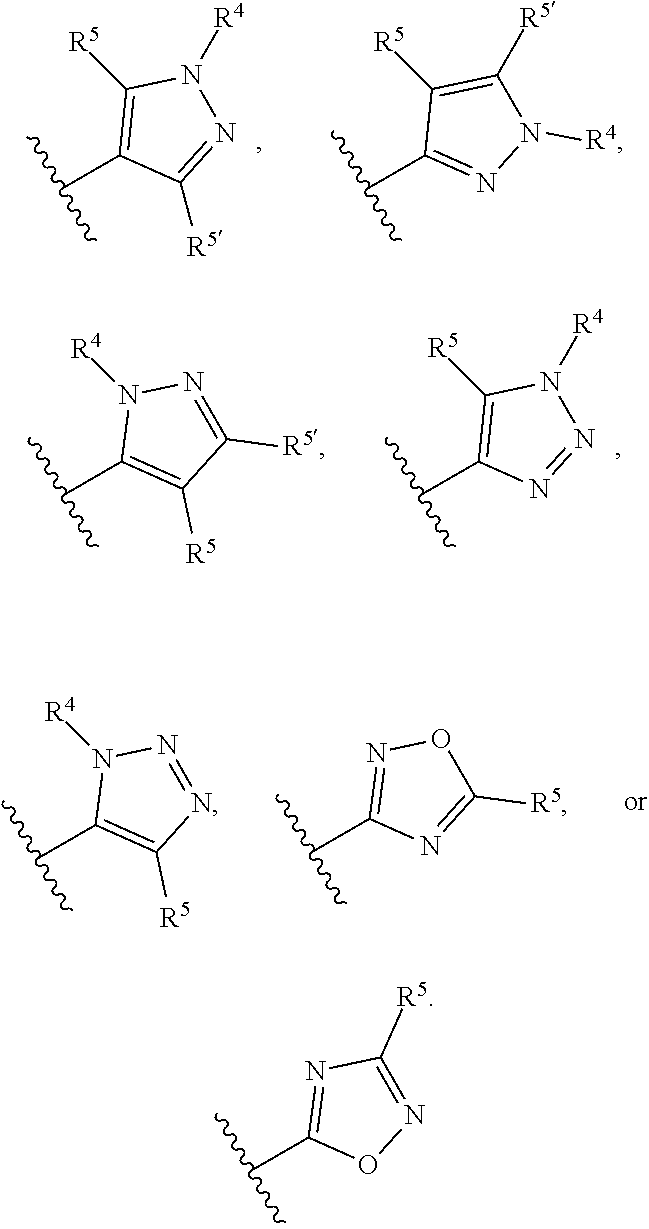Compounds and uses thereof
a technology of compounds and uses, applied in the field of compounds and uses thereof, can solve the problems of limited robust model system arsenal, inability to generate successful disease-modifying therapies against common and progressive neurological disorders, and provide very little reli
- Summary
- Abstract
- Description
- Claims
- Application Information
AI Technical Summary
Benefits of technology
Problems solved by technology
Method used
Image
Examples
example 1
on of N-(3,4-difluorobenzyl)-N-(1-(3,4-difluorobenzyl)-1H-pyrazol-4-yl)-5-(pyridin-2-yl)isoxazole-3-carboxamide (62)
[0709]
Step 1: Preparation of N-(1H-pyrazol-4-yl)-5-(pyridin-2-yl)isoxazole-3-carboxamide
[0710]
[0711]The mixture of 5-(pyridin-2-yl)isoxazole-3-carboxylic acid (190 mg, 1.0 mmol), 1H-pyrazol-4-amine (91 mg, 1.1 mmol) and 2-(7-aza-1H-benzotriazole-1-yl)-1,1,3,3-tetramethyluronium hexafluorophosphate (418 mg, 1.1 mmol) in N,N-dimethylformamide (5 mL) was added N,N-diisopropylethylamine (387 mg, 3.0 mmol). The mixture was stirred at 23° C. for 2 h. The reaction mixture was added dropwise to an ice-cooled solution of aqueous 0.5 hydrochloric acid (50 mL). The solid precipitate was collected by filtration and dried in vacuo to afford N-(1H-pyrazol-4-yl)-5-(pyridin-2-yl)isoxazole-3-carboxamide (215 mg, 0.84 mmol, 84%) as a pale-yellow solid. LCMS (ESI) m / z: 256.1 [M+H]+.
Step 2: Preparation of N-(1-(3,4-difluorobenzyl)-1H-pyrazol-4-yl)-5-(pyridin-2-yl)isoxazole-3-carboxamide a...
example 2
on of N-(1-benzylpyrazol-4-yl)-5-(2-fluorophenyl)isoxazole-3-carboxamide (38)
[0714]
Step 1: Preparation of ethyl 5-(2-fluorophenyl)isoxazole-3-carboxylate
[0715]
[0716]A mixture of ethyl 5-tributylstannylisoxazole-3-carboxylate (0.500 g, 1.16 mmol), 1-fluoro-2-iodo-benzene (0.272 mL, 2.32 mmol), bis(triphenylphosphine)palladium(II) dichloride (0.041 g, 0.058 mmol) in toluene (5 mL) was purged with nitrogen (3×), and then the mixture was stirred at 110° C. for 12 h under nitrogen. The mixture was cooled to 15° C. and then poured into ice-water (5 mL). The aqueous phase was extracted with ethyl acetate (10 mL×3). The combined organic layers were washed with brine (5 mL), dried with anhydrous sodium sulfate, filtered and concentrated in vacuo to afford crude product. The crude residue was purified by column chromatography (ISCO, 12 g silica, 0-50% ethyl acetate in petroleum ether, gradient over 30 min) to give ethyl 5-(2-fluorophenyl)isoxazole-3-carboxylate (0.200 g, crude) as a white sol...
example 3
on of N-(1-benzylpyrazol-4-yl)-5-(2-pyridyl)isoxazole-3-carboxamide (8)
[0721]
[0722]To a stirred solution of 1-benzylpyrazol-4-amine (0.120 g, 0.693 mmol) and 5-(pyridin-2-yl)isoxazole-3-carboxylic acid (0.157 g, 0.831 mmol) in N,N-dimethylformamide (1 mL) was added N,N,N′,N′-tetramethyl-O-(1H-benzotriazol-1-yl)uronium hexafluorophosphate (0.315 g, 0.831 mmol) and diisopropylethylamine (0.242 mL, 1.39 mmol) at 15° C., then stirred at 15° C. for 3 h. The reaction mixture was purified directly by prep-HPLC (Agela Venusil XBP C18 150×25 5 um column; 50%-75% acetonitrile in a 10 mM 0.04% ammonium hydroxide, 10 min gradient) to give N-(1-benzylpyrazol-4-yl)-5-(2-pyridyl)isoxazole-3-carboxamide (0.068 g, 0.197 mmol, 29%) as a pale yellow solid. 1H NMR (400 MHz, Chloroform-d) δ 8.76 (d, J=4.5 Hz, 1H), 8.55 (br. s, 1H), 8.06 (s, 1H), 7.97-7.92 (m, 1H), 7.91-7.84 (m, 1H), 7.64 (s, 1H), 7.44-7.31 (m, 5H), 7.30-7.26 (m, 2H), 5.32 (s, 2H); LCMS (ESI) m / z: 346.0 [M+H]+.
PUM
 Login to View More
Login to View More Abstract
Description
Claims
Application Information
 Login to View More
Login to View More - R&D
- Intellectual Property
- Life Sciences
- Materials
- Tech Scout
- Unparalleled Data Quality
- Higher Quality Content
- 60% Fewer Hallucinations
Browse by: Latest US Patents, China's latest patents, Technical Efficacy Thesaurus, Application Domain, Technology Topic, Popular Technical Reports.
© 2025 PatSnap. All rights reserved.Legal|Privacy policy|Modern Slavery Act Transparency Statement|Sitemap|About US| Contact US: help@patsnap.com



